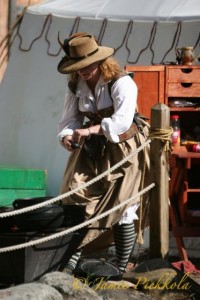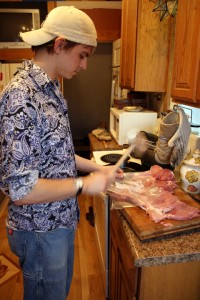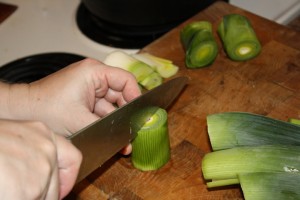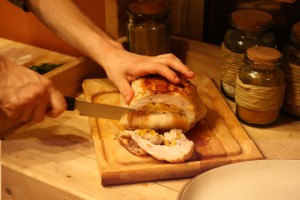Just like many cooks, I enjoy experimenting with different recipes, techniques, and flavors. Some things have worked and other have been disastrous. Several years ago, an experiments Nicholas and I tried worked out wonderfully. We created cedar smoked pork and it was heavenly. The recipe is simple, but not easily done in the safety of one’s own kitchen.
You will need a cast iron dutch oven, a holed cast iron plate (this can be picked up at a sporting store that carries cast iron cookery), dried cedar chips (other wood chips are fine if untreated). Some may prefer oak or wood from fruit bearing trees.
In a ceramic bowl, soak the wood chips in water for 4 hours. The dried wood chips will soak up the moisture and you will be ready to use them after the 4 hours. At the four hours, start your fire pit or barbecue so that it is nice and hot.

Remove the excess water from the bowl and add the re hydrated wood chips to the bottom of the cast iron pot. This should be no higher than an inch and a half from the bottom. Place the cast iron plate on top of the chips. It’s best that you brush the top of the cast iron plate with oil to keep the meat from sticking. Add the pork (I prefer pork shoulder as it is well marbled) and sprinkle fine sea salt and fresh ground pepper and add the lid. Place the cast iron pot on the grill or fire pit to begin the cooking process.
Visit the pot every 15 minutes. The heat will quickly boil off the water and cause the wood to smoke. You do not want the wood to burn or catch fire so when you notice that the wood is beginning to emit a lot of smoke, add a cup of water to the wood. Make sure you keep the lid on the pot to keep the smoke in the pot and the heat in. After 45 minutes to an hour check the temperature of the meat; it should read about 170 degree.
The smoking of the meat will keep it moist and flavorful. Friends have enjoyed the pork with barbecue sauce, but I like it just the way it is.
* This recipe can be done with fish, chicken, and turkey as well as wild bird game.
Wild rice and wheatberry salads and side dishes best complement this dish.






